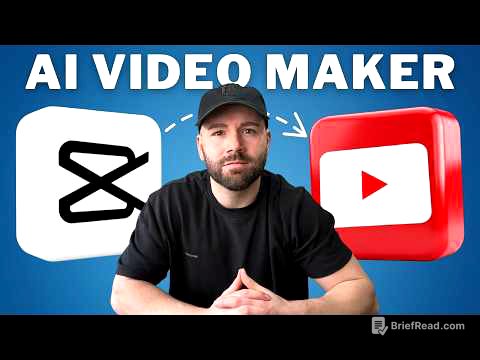TLDR;
This YouTube video transcript details Iman Gadzhi's presentation on scaling info product businesses, aimed at those already making $20,000 to $100,000 per month. He introduces his five info product scaling systems: Content, Revenue Events, Business Intelligence, Talent Acquisition Funnel, and Operations, emphasizing profit over revenue. The presentation promises to reveal the secrets to consistent year-on-year growth, even in a challenging market, and includes a behind-the-scenes look at his business strategies.
- Focus on profit over revenue for sustainable growth.
- Implement five key systems: Content, Revenue Events, Business Intelligence, Talent Acquisition, and Operations.
- Content should create pent-up demand, which is then liquidated through strategic revenue events.
Introduction and Expectations [1:55]
Iman Gadzhi welcomes the audience to a live webinar focused on the info business, particularly for those already earning between $20,000 and $100,000 per month. He mentions recent masterminds with top clients, emphasizing that the content will cover strategies for growth, adaptation, and improvement in the evolving info space. The goal is to help businesses escape the "infograde depression" and join the "info upper class" by implementing five info product scaling systems. He sets expectations for a practical, in-depth presentation lasting about 1.5 to 2 hours, with transparency regarding profit numbers and backend systems.
Presentation Overview and Philosophy [4:50]
Iman outlines the three-day plan, aiming to demonstrate why many info businesses in the $20,000 to $100,000 per month range may fail within 24 months. He intends to share the strategies that have enabled his business to achieve eight years of year-on-year growth and profit. The presentation will cover a 12-step plan, incorporating five key systems designed to keep businesses ahead of the competition. He emphasizes that the content is designed for serious info people and will be tactical rather than motivational.
Event Details and Transparency [8:08]
Iman explains that the presentation will focus on systems, including content creation, running eight-figure events, lead scoring, conversion rate optimization, and hiring funnels. He notes that the first 15 to 20 minutes will cover the theory and his worldview on the info business. He mentions that this free event contains content similar to what clients pay $18,000 to $25,000 for, and is geared towards those already making $20,000 to $100,000 a month, not beginners. He asks attendees to engage by using the hashtag #itpaid when they find value in the content, and discloses that there will be an offer at the end for a high-end coaching program.
Background and Accomplishments [16:15]
Iman provides a brief background, stating he began selling digital products nine years ago and created his first seven-figure info product in 2019. He highlights the success of Agency Navigator and mentions closing his most successful eight-figure event recently. He emphasizes his ability to thrive in a challenging info space where many others are struggling or have gone out of business. In total, he's collected over $100 million cash from his info business with 75% profit margins and has eight years of year-on-year growth in profit. He also mentions his co-ownership of WAP, a digital product platform processing $15 to $120 million a month for creators, giving him access to extensive data on what works in the industry.
The Premise of Profit Over Revenue [22:19]
Iman reveals that his long-term success is due to prioritizing profit over revenue. He identifies five key levers for scaling while maintaining high cash margins: Content, Revenue Events, Business Intelligence, Talent Acquisition Funnel, and Operations. These systems are essential for reaching and staying in the "info upper class," scaling past $200,000 a month in profit. He uses the analogy of a watch, stating that all gears (systems) must work together in sync to avoid breaking down.
Diagnosing Bottlenecks in Your Business [25:59]
Iman compares a business to a vintage 5-cylinder race car, where all cylinders (systems) must fire in perfect rhythm for smooth, effortless performance. If one cylinder misfires, the business crawls despite significant effort. He introduces a "bottleneck compass diagnostic" to pinpoint which systems are lacking and causing the biggest bottlenecks. He then poses diagnostic questions for each of the five systems to help attendees identify their primary areas of weakness.
The Five Systems: Content, Revenue Events, and Business Intelligence [27:56]
Iman details the first three systems. For Content, he asks if the business depends on paid traffic, if views are climbing but sales are flat, if hard pitches are needed in every piece of content, and if paid traffic Customer Acquisition Cost (CAC) is above 55% of Average Order Value (AOV). The fix is a content system that compounds, pushing traffic back to a money-making VSSL (Video Sales Letter). For Revenue Events, he asks if the audience is growing but revenue is flat, if the business is stuck at a plateau, if webinar show-up rates are dropping, and if bigger bonuses are needed to get people to buy. The fix is time-boxed revenue events that liquidate pent-up demand with high margins. For Business Intelligence, he asks if VSSL or webinar conversion rates are declining, if leads never buy, and if Cost Per Mille (CPM) is going up while Return On Ad Spend (ROAS) is going down. The fix is a lead scoring system that grades prospects before they enter the funnel.
The Five Systems: Talent Acquisition and Operating System [32:35]
Iman continues detailing the last two systems. For Talent Acquisition, he asks if the team constantly asks what to do, if nothing moves without direct involvement, and if losing one "A player" would collapse the operation. The fix is a talent acquisition system that attracts committed "A players." For the Operating System, he asks if the business owner is involved in every project meeting, if projects stall waiting for approval, and if the owner's name is on more than 10% of tasks. The fix is automated workflows, decision trees, and Standard Operating Procedures (SOPs) that allow the team to execute flawlessly.
Interdependence of Systems and Content System Deep Dive [35:51]
Iman emphasizes that the five systems don't work in isolation and must be built in the right sequence to amplify each other. He notes that content without revenue events is just traffic without monetization, and revenue events without business intelligence are cash surges with garbage leads. He then dives into the flywheel content system, explaining that with rising CPMs and declining conversion rates, acquiring customers for free or getting paid to acquire them is essential. He shares an example of a video that earned him $267,000 from Google and generated $20 million in profit, demonstrating a negative CAC.
Flywheel Content System and Algorithm Hacking [39:03]
Iman explains that a flywheel content system helps decrease CAC on paid traffic by creating a warm audience. He contrasts traditional funnels with the flywheel system, where every new video links back to an evergreen VSSL, creating compounding momentum. He then shares how to "hack" the YouTube algorithm by focusing on click-through rate (CTR) and session time. He emphasizes that YouTube measures the time of the entire session a video creates, not just the video watch time.
Finding Profitable Topics and Action Plan [47:58]
Iman reveals his method for finding profitable topics: answering the audience's most asked questions. He advises against optimizing solely for views, as attracting an unqualified audience is easy but doesn't lead to sales. Instead, he recommends focusing on playback-based CPM, which indicates how much advertisers are willing to pay to put ads on a specific video, reflecting the audience's monetization potential. He then outlines a 7-day action plan to implement the flywheel content system, including feeder R&D, picking winners based on CPM and views, promoting to a flywheel VSSL, retrofitting feeder videos, and perpetual spinning.
The Importance of Pent-Up Demand and Business Intelligence Introduction [1:00:40]
Iman stresses that content alone won't sell a product; it creates pent-up demand, which must be liquidated systematically. He transitions to the next system, Business Intelligence, noting that implementing this system was a major inflection point in his business, leading to a significant profit jump without changing copy, offer, or price. He emphasizes that this system has allowed him to double, triple, and even 5x his ad spend while increasing ROAS at a much lower risk.
Business Intelligence: Lead Scoring and Optimization [1:05:07]
Iman explains that with his business intelligence system, he knows which leads will bring the most revenue before even pitching his product. He argues that it makes no sense to optimize for the cheapest cost per lead and that the biggest competitive advantage is a hungry crowd. He shares that he breaks down his leads into four tiers based on their potential conversion rate and optimizes his campaigns for the highest-quality leads. He also tailors his approach to each category of lead, providing concierge service to the most promising ones.
Business Intelligence: Data Points and Implementation [1:16:21]
Iman details the data points he uses to score leads, including the source of the lead, age, country, prior online business experience, level of education, employment status, monthly income, and savings. He emphasizes the importance of setting up custom scores based on historical data and continuously optimizing the scoring system. He outlines the flow: ads, registration page, survey page (using Typeform), Google BigQuery for data storage, Looker Studio for analysis, and Meta CAPI for custom events.
Business Intelligence: Real-World Results and Revenue Events Introduction [1:24:29]
Iman shares real-world results, showing how his lead scoring system has shifted his lead volume from low-quality leads to high-quality leads, increasing his average conversion rate. He emphasizes that this level of business intelligence separates those who thrive from those who fail due to ad inflation. He then transitions to the next system, Revenue Events, explaining that relying solely on VSSL funnels, automated webinar funnels, or call funnels leads to revenue plateaus and audience fatigue.
Revenue Events: Structure and Assets [1:30:17]
Iman explains that instead of selling every day, businesses should sell in contained events, creating concentrated cash surges. He outlines the overall structure of revenue events: three to four weeks of lead capture, one to seven days of the event, and two to seven days of open cart. He details the five assets needed to run a revenue event: ads, a trailer, a registration flow, episodes, and a sales page. He also shares a tip about adding a one-time offer page to the registration flow to recoup ad spend.
Revenue Events: Types and Conclusion [1:49:39]
Iman describes six proven types of revenue events: 5-day live challenge, paid workshop, three or four-part series, secret Zoom, 48-hour sale, and live webinar. He advises picking one type and mastering it before adding another. He concludes by reiterating that every problem in an info business stems from a lack of one or more of the five info product scaling systems. He previews the next sessions, promising a step-by-step action plan to implement these systems and ensure long-term survival in the info business.

![How Doctor Who's Missing Episodes Came Back [Part 3]](https://wm-img.halpindev.com/p-briefread_c-10_b-10/urlb/aHR0cDovL2ltZy55b3V0dWJlLmNvbS92aS9FbnBEeUhsT0RtSS9ocWRlZmF1bHQuanBn.jpg)







